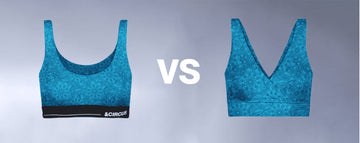Picture this: you're in the heart of Mumbai's chaotic streets, where the monsoon rains have just cleared, leaving a steamy haze that clings to everything. Amid the rush, what you wear closest to your skin suddenly matters more than ever not just for comfort, but for the story it tells about your values. Across India, from the tech-savvy corridors of Bengaluru to the historic lanes of Chennai, a subtle yet profound shift is transforming how people choose their most intimate apparel. No longer satisfied with disposable, environmentally taxing options, consumers are demanding underwear that embodies sustainability, ethics, and smart design.
Uncomfortable underwear shouldn't steal your confidence. At Andcircus, we craft ultra-soft, sustainable Lenzing Modal Micro® innerwear for every body, XS to 5XL. From briefs to bras, our custom packs fit you perfectly. Shop risk-free with our 100% satisfaction guarantee and embrace comfort that includes everyone. #LoveEveryBody. Shop Now!
What Indian Consumers Value Most in Sustainable Underwear Brands
From innovative eco-fabrics to inclusive styling, shoppers in states like Maharashtra, Tamil Nadu, Delhi, and more are driving a seismic change in the intimate apparel sector, pushing brands toward greener, more thoughtful practices.
Why Sustainable Underwear Matters Now
The environmental crisis isn't abstract in India it's felt in Delhi's smog-choked skies and Kerala's flooding-prone coasts. As awareness grows, so does scrutiny over everyday items like underwear, which contribute to the massive waste from fast fashion. Synthetic materials derived from petroleum not only pollute during production but also linger in landfills for centuries. In contrast, sustainable alternatives offer a path forward, blending personal well-being with planetary health.
In humid hotspots such as Tamil Nadu and Kerala, breathable fabrics like organic cotton and bamboo are gaining traction for their natural moisture-wicking properties. These materials reduce skin irritations common in tropical climates while minimizing chemical use in farming. Social media platforms amplify this shift; on Instagram and Pinterest, users exchange ideas on swapping out harmful synthetics for earth-friendly choices. Feeds from influencers like desouzamesty or taleofourtrails illustrate how these small decisions accumulate into meaningful environmental impact.
This momentum isn't confined to trends it's rooted in deeper societal changes. In Maharashtra's bustling markets and Karnataka's innovation-driven ecosystems, conversations over casual meetups often turn to label-reading and supply chain ethics. Brands emphasizing fair labor practices resonate here, as consumers increasingly link their purchases to worker's rights. The dialogue extends to specialized needs, such as maternity wear in Chennai, where pregnant women prioritize non-toxic, gentle fabrics that support both maternal health and infant safety. Platforms like Facebook and YouTube fuel this with in-depth videos analyzing product lifecycles, from farm to wardrobe.
Further north and east, in Uttar Pradesh and West Bengal, where cultural heritage meets modern aspirations, Reddit forums buzz with debates on ethical manufacturing. Families in these regions seek durable, eco-conscious options that withstand daily wear without straining budgets, demonstrating how sustainability is democratizing beyond urban elites into broader communities.
Globally, the sustainable underwear market underscores this urgency. Valued at around $500 million as of 2025, it's set to grow at a compound annual rate of 12% through 2033. This surge stems from heightened awareness of the ecological and societal drawbacks of traditional textiles, with preferences shifting toward organic cotton, bamboo, and hemp. Ethical supply chains and fair labor are pivotal, as buyers show readiness to invest more in value-aligned products. In the Asia Pacific region, including India, this growth is particularly pronounced, driven by rising demand for eco-friendly intimates across diverse climates and demographics.
Emerging Trends in Consumer Demand
Peeling back the layers reveals clear patterns shaping the market. Tamil Nadu's rich textile legacy fuels a boom in chemical-free organic cotton blends, ideal for humidity management. Similarly, Kerala's environmentally attuned residents favor biodegradable options that harmonize with their natural surroundings, offering practical benefits like reduced allergies alongside moral satisfaction.
Inclusivity is another cornerstone. In Delhi's multicultural melting pot and Karnataka's forward-thinking circles, gender-neutral designs are breaking barriers. Universal prints and cuts appeal across spectra, fostering a sense of belonging. Visualize vibrant, boundary-pushing patterns that echo the flair seen in the urban dandy's aesthetic or Mohit Watwanii's bold expressions on social media.
Digital channels are pivotal in this evolution. Influencers such as Shaina Tanna and Arushi Sayal go beyond aesthetics, educating audiences on sustainability's nuances. Browsing profiles like 12thmancornerbydiya or Khusshi Bedi shows how these narratives convert curiosity into action. In Haryana and Gujarat, where social bonds are strong, Pinterest mood boards spread these ideas organically, turning eco-underwear into a collective goal.
Value consciousness defines choices in Uttar Pradesh and West Bengal, where buyers balance affordability with longevity. They pursue ethical fabrics that endure, reflecting a pragmatic approach to sustainability. Telangana's expanding middle class echoes this, emphasizing hypoallergenic qualities for routine comfort.
Transparency reigns supreme across all these areas. Shoppers interrogate brands on origins, eco-certifications, and real-world effects. Reddit discussions pit bamboo against hemp, while YouTube breakdowns demystify green credentials, empowering informed decisions.
These trends aren't isolated; they interconnect, creating a holistic demand for underwear that performs environmentally, socially, and personally. As awareness spreads, expect even more nuanced preferences, like adaptive features for varying body types or integrated tech for health monitoring.
Real-World Examples and Case Studies
In Maharashtra, Mumbai's boutique scene pioneers recycled fabric innovations, creating seamless, waste-reducing designs that prioritize ease. Gujarat's artisans merge age-old techniques with contemporary sustainability, crafting heirloom-quality pieces that honor tradition while embracing green principles.
Tamil Nadu's maternity segment is booming, with women opting for dye-free, expandable organics that adapt to bodily changes under the relentless sun. This functional empowerment shines through in Gowrie Parvathy's motivational content and Radha Kashyap's everyday shares on Instagram.
Influencer partnerships crystallize these shifts. Desouzamesty's vibrant styling demonstrates eco-underwear's versatility in daily life, while taleofourtrails proves its resilience in outdoor pursuits. Delhi's market responds strongly to these, converting endorsements into widespread adoption.
In Haryana's emerging scenes, temporary pop-ups showcase straightforward, unisex sustainable options, emphasizing reliability over extravagance. These initiatives highlight how localized efforts can spark broader interest, even in underserved areas.
Case studies from across India reveal success stories: brands collaborating with local weavers in West Bengal to produce hemp-based lines, or digital campaigns in Telangana that leverage user-generated content on Facebook to build trust. Such examples illustrate the tangible benefits of aligning with consumer values.
Key Challenges, Limitations, and Risks
Despite progress, obstacles persist. In Haryana and Delhi, playful aesthetics often overshadow functionality, with consumers desiring advanced features like superior wicking or antimicrobial properties to suit dynamic routines.
Distribution remains a bottleneck. While Uttar Pradesh and Telangana hold potential, scarce physical outlets limit access. Digital alternatives mitigate this somewhat, but uneven internet in rural zones creates disparities. Strategies like precise Facebook targeting or Reddit engagement could help close these gaps.
Cost barriers are evident: Delhi's affluent may embrace premiums, but Gujarat and West Bengal's mid-tier markets balk, favoring economical standbys. Brands must demonstrate superior longevity to justify prices, perhaps through warranties or comparative studies.
Doubts about durability in India's extreme weather linger, especially in rain-soaked Kerala. Educating via compelling narratives on YouTube and Pinterest is essential to counter misconceptions and build confidence.
Supply chain vulnerabilities add risks fluctuating raw material costs or regulatory changes could disrupt progress. Yet, these challenges also spur innovation, encouraging brands to diversify sources and enhance resilience.
Opportunities and Business Impacts
Opportunities abound amid these hurdles. Signature blends of organic materials cater to India's climatic diversity, from northern chills to southern swelters, establishing brands as versatile leaders.
Digital frontiers offer vast potential. Instagram and Facebook host thriving eco-dialogues; authentic participation can foster loyal communities. Reddit enables specialized discussions, and Pinterest sparks inspiration through visuals.
Niches like maternity and inclusivity glow brightly. Kerala's wellness-focused demographic demands allergen-free innovations; Tamil Nadu's prenatal needs call for toxin-free comfort. Karnataka's inclusive ethos welcomes gender-fluid offerings.
Evolving retail models pop-ups in Uttar Pradesh, hybrid approaches in Telangana expand footprints. Teaming with influencers like theurbandandy transforms visibility into sales.
Streamlined constructions reduce waste and returns, enhancing profitability. Tackling concerns directly integrating performance tech, broadening availability turns skeptics into advocates, driving long-term growth. Businesses ignoring these will falter; those adapting reap rewards in loyalty and market share.
Expert Insights and Future Outlook
In summary, consumers across India's priority regions demand sustainable underwear that fuses eco-responsibility with practicality: supreme comfort, broad inclusivity, and reasonable pricing are essentials.
Projecting forward, this sector will normalize within three to five years, spearheaded by metropolises like Delhi, Mumbai, and Bengaluru, with expansion into West Bengal's hinterlands and Gujarat's communities.
The formula for success lies in merging indigenous ingenuity such as regional textiles with compelling online narratives. Brands that actively heed feedback, innovate accordingly, and connect genuinely will elevate underwear from mere necessity to a symbol of conscious living.
Frequently Asked Questions
What materials do Indian consumers prefer in sustainable underwear brands?
Indian consumers increasingly favor eco-friendly materials like organic cotton, bamboo, and hemp for their underwear. These natural fabrics offer superior breathability and moisture-wicking properties, which are especially valued in humid regions like Tamil Nadu and Kerala. Organic cotton blends are particularly popular due to their chemical-free production and comfort in India's diverse climatic conditions.
Why is sustainable underwear becoming more popular in India?
The sustainable underwear market in India is growing due to increased environmental awareness and health consciousness among consumers. With the global sustainable underwear market valued at $500 million in 2025 and growing at 12% annually, Indian consumers are rejecting fast fashion's environmental impact in favor of durable, ethically-made intimate apparel. The shift is particularly pronounced in metropolitan areas like Mumbai, Delhi, and Bengaluru, where consumers link their purchases to both personal well-being and planetary health.
What challenges do sustainable underwear brands face in the Indian market?
Sustainable underwear brands in India face several key challenges including higher costs compared to conventional options, limited physical distribution networks especially in rural areas, and consumer skepticism about durability in extreme weather conditions. While affluent consumers in cities like Delhi readily embrace premium pricing, mid-tier markets in states like Gujarat and West Bengal require brands to demonstrate superior longevity and value to justify the higher costs of eco-friendly materials.
Disclaimer: The above helpful resources content contains personal opinions and experiences. The information provided is for general knowledge and does not constitute professional advice.
You may also be interested in: How Inclusivity Is Reshaping the Plus-Size Underwear Market
Uncomfortable underwear shouldn't steal your confidence. At Andcircus, we craft ultra-soft, sustainable Lenzing Micro Modal innerwear for every body, XS to 5XL. From briefs to bras, our custom packs fit you perfectly. Shop risk-free with our 100% satisfaction guarantee and embrace comfort that includes everyone. #LoveEveryBody. Shop Now!







































